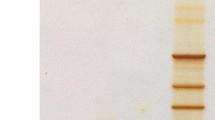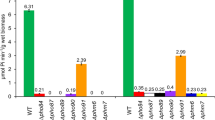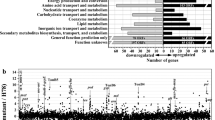Abstract
Phosphate homeostasis is tightly regulated in bacteria. Phosphate scarcity is overcome by inducing the expression of genes associated with the scavenging of phosphate and phosphate-containing molecules, while phosphate surplus is stored in the form of polyphosphate (polyP). Regulation of the genes involved in polyP metabolism was investigated. Knockout of the most distal gene of the pstSCAB-phoU operon that encodes a Pi-transport system results in large accumulation of polyphosphate (polyP). Here, we show that the phoU mutation differentially affects the transcription of ppk and ppx, that respectively, encode a polyP kinase and a polyP exopolyphosphatase, by increasing the former and reducing the latter, further contributing the accumulation of polyP. We also show that ppk forms an operon with the upstream gene hemB and that neither ppk nor ppx positively respond to Pi starvation. Furthermore, a putative PHO-box sequence in ppx regulatory region did not show a strong affinity for the PHO response regulator PhoB, while the promoter of hemB does not carry a PHO-box sequence. Altogether, the data indicate that the main genes involved in polyP metabolism, ppk and ppx, are differentially regulated in the absence of phoU, but neither gene belongs to the PHO regulon.





Similar content being viewed by others
References
Akiyama M, Crooke E, Kornberg A (1993) An exopolyphosphatase of Escherichia coli. The enzyme and its ppx gene in a polyphosphate operon. J Biol Chem 268:633–639
Azevedo C, Saiardi A (2016) The new world of inorganic polyphosphates. Biochem Soc Trans 44:13–17. doi:10.1042/BST20150210
Bains M, Fernández L, Hancock RE (2012) Phosphate starvation promotes swarming motility and cytotoxicity of Pseudomonas aeruginosa. Appl Environ Microbiol 78:6762–6768
Becher A, Schweizer H (2000) Integration-proficient Pseudomonas aeruginosa vectors for isolation of single-copy chromosomal lacZ and lux gene fusions. Biotechniques 29:948–952
Chekabab SM, Harel J, Dozois CM (2014) Interplay between genetic regulation of phosphate homeostasis and bacterial virulence. Virulence 5:786–793. doi:10.4161/viru.29307
Choi KH, Kumar A, Schweizer HP (2006) A 10-min method for preparation of highly electrocompetent Pseudomonas aeruginosa cells: application for DNA fragment transfer between chromosomes and plasmid transformation. J Microbiol Methods 64:391–397. doi:10.1016/j.mimet.2005.06.001
Darzins A, Chakrabarty A (1984) Cloning of genes controlling alginate biosynthesis from a mucoid cystic fibrosis isolate of Pseudomonas aeruginosa. J Bacteriol 159:9–18
de Almeida LG, Ortiz JH, Schneider RP, Spira B (2015) phoU inactivation in Pseudomonas aeruginosa enhances accumulation of ppGpp and polyphosphate. Appl Environ Microbiol 81:3006–3015. doi:10.1128/AEM.04168-14
Frankenberg N, Kittel T, Hungerer C, Römling U, Jahn D (1998) Cloning, mapping and functional characterization of the hemB gene of Pseudomonas aeruginosa, which encodes a magnesium-dependent 5-aminolevulinic acid dehydratase. Mol Gen Genet 257:485–489
Gaca AO, Colomer-Winter C, Lemos JA (2015) Many means to a common end: the intricacies of (p)ppGpp metabolism and its control of bacterial homeostasis. J Bacteriol 197:1146–1156. doi:10.1128/JB.02577-14
Gallarato LA, Sánchez DG, Olvera L, Primo ED, Garrido MN, Beassoni PR, Morett E, Lisa AT (2014) Exopolyphosphatase of Pseudomonas aeruginosa is essential for the production of virulence factors, and its expression is controlled by NtrC and PhoB acting at two interspaced promoters. Microbiology 160:406–417
Gardner SG, Johns KD, Tanner R, McCleary WR (2014) The PhoU protein from Escherichia coli interacts with PhoR, PstB, and metals to form a phosphate-signaling complex at the membrane. J Bacteriol 196:1741–1752
Gray MJ, Jakob U (2015) Oxidative stress protection by polyphosphate—new roles for an old player. Curr Opin Microbiol 24:1–6
Griffith KL, Wolf RE Jr (2002) Measuring \(\beta\)-galactosidase activity in bacteria: cell growth, permeabilization, and enzyme assays in 96-well arrays. Biochem Biophys Res Commun 290:397–402
Gummesson B, Lovmar M, Nyström T (2013) A proximal promoter element required for positive transcriptional control by guanosine tetraphosphate and DksA protein during the stringent response. J Biol Chem 288:21055–21064. doi:10.1074/jbc.M113.479998
Hancock R, Poole K, Benz R (1982) Outer membrane protein P of Pseudomonas aeruginosa regulation by phosphate deficiency and formation of small anion-specific channels in lipid bilayer membranes. J Bacteriol 150:730–738
Hancock R, Raffle V, Nicas T (1981) Involvement of the outer membrane in gentamicin and streptomycin uptake and killing in Pseudomonas aeruginosa. Antimicrob Agents Chemother 19:777–785
Harold FM (1966) Inorganic polyphosphates in biology: structure, metabolism, and function. Bacteriol Rev 30:772–794
Hoang T, Karkhoff-Schweizer R, Kutchma A, Schweizer H (1998) A broad-host-range Flp-FRT recombination system for site-specific excision of chromosomally-located DNA sequences: application for isolation of unmarked Pseudomonas aeruginosa mutants. Gene 212:77–86
Ishige K, Kameda A, Noguchi T, Shiba T (1998) The polyphosphate kinase gene of Pseudomonas aeruginosa. DNA Res 5:157–162
Jensen V, Löns D, Zaoui C, Bredenbruch F, Meissner A, Dieterich G, Münch R, Häussler S (2006) RhlR expression in Pseudomonas aeruginosa is modulated by the Pseudomonas quinolone signal via PhoB-dependent and -independent pathways. J Bacteriol 188:8601–8606. doi:10.1128/JB.01378-06
Kornberg A (1999) Inorganic polyphosphate: a molecule of many functions. Prog Mol Subcell Biol 23:1–18
Kulaev I, Vagabov V, Kulakovskaya T (2005) The biochemistry of inorganic polyphosphates. Wiley, Chichester
Kuroda A, Murphy H, Cashel M, Kornberg A (1997) Guanosine tetra- and pentaphosphate promote accumulation of inorganic polyphosphate in Escherichia coli. J Biol Chem 272:21240–21243
Li Y, Zhang Y (2007) PhoU is a persistence switch involved in persister formation and tolerance to multiple antibiotics and stresses in Escherichia Coli. Antimicrob Agents Chemother 51:2092–2099
Lubin EA, Henry JT, Fiebig A, Crosson S, Laub MT (2016) Identification of the PhoB regulon and role of PhoU in the phosphate starvation response of Caulobacter crescentus. J Bacteriol 198:187–200. doi:10.1128/JB.00658-15
McCleary W (1996) The activation of PhoB by acetylphosphate. Mol Microbiol 20:1155–1163
McCleary WR, Stock JB (1994) Acetyl phosphate and the activation of two-component response regulators. J Biol Chem 269:31567–31572
Miller JH (1992) A short course in bacterial genetics: a laboratory manual and handbook for Escherichia coli and related bacteria. Cold Spring Harbor Laboratory Press, Plainview
Moreno SN, Docampo R (2013) Polyphosphate and its diverse functions in host cells and pathogens. PLoS Pathog 9:e1003230. doi:10.1371/journal.ppat.1003230
Morohoshi T, Maruo T, Shirai Y, Kato J, Ikeda T, Takiguchi N, Ohtake H, Kuroda A (2002) Accumulation of inorganic polyphosphate in phoU mutants of Escherichia coli and Synechocystis sp. strain PCC6803. Appl Environ Microbiol 68:4107–4110
Omelon S, Georgiou J, Habraken W (2016) A cautionary (spectral) tail: red-shifted fluorescence by DAPI-DAPI interactions. Biochem Soc Trans 44:46–49. doi:10.1042/BST20150231
Pisani F, Livermore T, Rose G, Chubb JR, Gaspari M, Saiardi A (2014) Analysis of dictyostelium discoideum inositol pyrophosphate metabolism by gel electrophoresis. PLoS One 9:e85533. doi:10.1371/journal.pone.0085533
Rahme L, Stevens E, Wolfort S, Shao J, Tompkins R, Ausubel F (1995) Common virulence factors for bacterial pathogenicity in plants and animals. Science 268:1899–1902
Ramsey DM, Wozniak DJ (2005) Understanding the control of Pseudomonas aeruginosa alginate synthesis and the prospects for management of chronic infections in cystic fibrosis. Mol Microbiol 56:309–322. doi:10.1111/j.1365-2958.2005.04552.x
Rao N, Liu S, Kornberg A (1998) Inorganic polyphosphate in Escherichia coli: the phosphate regulon and the stringent response. J Bacteriol 180:2186–2193
Rao NN, Gómez-García MR, Kornberg A (2009) Inorganic polyphosphate: essential for growth and survival. Annu Rev Biochem 78:605–647
Sambrook J, MacCallum P, Russell DW (2001) Molecular cloning: a laboratory manual, 3rd edn. Cold Spring Harbor Laboratory Press, Cold Spring Harbor
Shortridge VD, Lazdunski A, Vasil ML (1992) Osmoprotectants and phosphate regulate expression of phospholipase C in Pseudomonas aeruginosa. Mol Microbiol 6:863–871
Silby M, Nicoll J, Levy S (2009) Requirement of polyphosphate by Pseudomonas fluorescens Pf0-1 for competitive fitness and heat tolerance in laboratory media and sterile soil. Appl Environ Microbiol 75:3872–3881
Spira B, Aguena M, Castro Oliveira JV, Yagil E (2010) Alternative promoters in the pst operon of Escherichia coli. Mol Genet Genomics 284:489–498
Spira B, Ferenci T (2008) Alkaline phosphatase as a reporter of sigma(S) levels and rpoS polymorphisms in different E. coli strains. Arch Microbiol 189:43–47. doi:10.1007/s00203-007-0291-0
Spira B, Ferreira GM, de Almeida LG (2014) relA enhances the adherence of enteropathogenic Escherichia coli. PLoS One 9:e91703. doi:10.1371/journal.pone.0091703
Svitil A, Cashel M, Zyskind J (1993) Guanosine tetraphosphate inhibits protein synthesis in vivo. a possible protective mechanism for starvation stress in Escherichia coli. J Biol Chem 268:2307–2311
Van Dien SJ, Keasling J (1999) Control of polyphosphate metabolism in genetically engineered Escherichia coli. Enzyme Microb Technol 24:21–25
van Veen HW, Abee T, Kortstee GJ, Pereira H, Konings WN, Zehnder AJ (1994) Generation of a proton motive force by the excretion of metal-phosphate in the polyphosphate-accumulating Acinetobacter johnsonii strain 210A. J Biol Chem 269:29509–29514
Wanner BL (1996) Phosphorus assimilation and control of the phosphate regulon. In: Escherichia coli and Salmonella: celular and molecular biology. American Society for Microbiology, p 1357–1381
Wenner N, Maes A, Cotado-Sampayo M, Lapouge K (2014) NrsZ: a novel, processed, nitrogen-dependent, small non-coding RNA that regulates Pseudomonas aeruginosa PAO1 virulence. Environ Microbiol 16:1053–1068
Winsor GL, Griffiths EJ, Lo R, Dhillon BK, Shay JA, Brinkman FSL (2016) Enhanced annotations and features for comparing thousands of Pseudomonas genomes in the Pseudomonas genome database. Nucleic Acids Res 44:D646–D653. doi:10.1093/nar/gkv1227
Yuan ZC, Zaheer R, Morton R, Finan TM (2006) Genome prediction of PhoB regulated promoters in Sinorhizobium meliloti and twelve proteobacteria. Nucleic Acids Res 34:2686–2697
Zaborina O, Holbrook C, Chen Y, Long J, Zaborin A, Morozova I, Fernandez H, Wang Y, Turner JR, Alverdy JC (2008) Structure–function aspects of PstS in multi-drug-resistant Pseudomonas aeruginosa. PLoS Pathog 4:e43. doi:10.1371/journal.ppat.0040043
Zago A, Chugani S, Chakrabarty A (1999) Cloning and characterization of polyphosphate kinase and exopolyphosphatase genes from Pseudomonas aeruginosa 8830. Appl Environ Microbiol 65:2065–2071
Zhang H, Ishige K, Kornberg A (2002) A polyphosphate kinase (PPK2) widely conserved in bacteria. Proc Natl Acad Sci USA 99:16678–16683
Zhang X, Bremer H (1995) Control of the Escherichia coli rrnB P1 promoter strength by ppGpp. J Biol Chem 270:11181–11189
Acknowledgments
The authors thank Cristiane Guzzo, Regina Baldini and Shaker Chuck Farah for providing strains, equipment and helpful advices.
Author information
Authors and Affiliations
Corresponding author
Ethics declarations
This article does not contain any studies with human participants or animals performed by any of the authors.
Funding
We are grateful to Fundação de Amparo à Pesquisa do Estado de São Paulo (FAPESP) and to the Conselho Nacional de Desenvolvimento Científico e Tecnológico (CNPq) for supporting this study. N.F.V.M. and L.G.A. were supported by FAPESP scholarships.
Additional information
Communicated by S. Hohmann.
Electronic supplementary material
Below is the link to the electronic supplementary material.
Rights and permissions
About this article
Cite this article
Munévar, N.F.V., de Almeida, L.G. & Spira, B. Differential regulation of polyphosphate genes in Pseudomonas aeruginosa . Mol Genet Genomics 292, 105–116 (2017). https://doi.org/10.1007/s00438-016-1259-z
Received:
Accepted:
Published:
Issue Date:
DOI: https://doi.org/10.1007/s00438-016-1259-z




